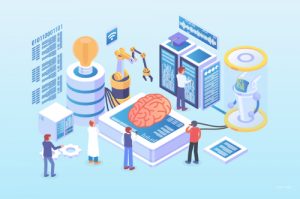Machine Learning for Everyone. A Quick Guide to Get the Basics Right!
“A breakthrough in machine learning would be worth ten Microsofts”. - Bill Gates, Former Chairman, Microsoft
Machine Learning (ML) has been buzzing around for some years. It is the hottest domain in the market and everybody seems to have an opinion about it. You can hear people commenting on it as the future with full conviction. Though you have agreed with them to avoid awkwardness and the embarrassment of being left behind in knowledge, don’t you think you need to get the basics right?
This blog is a quick and comprehensive guide to get an uncomplicated foundational knowledge on Machine Learning.
Are Machine Learning and Artificial Intelligence the Same?
Every Tom, Dick, and Harry are talking about Machine Learning and Artificial Intelligence as though these two terms share the same meaning. Even the media sometimes use the two terms interchangeably promoting further confusion. Knowing the difference between these terms will make you talk about it with clarity.
Machine Learning is a subset of Artificial Intelligence making AI a bigger concept realm. A quick definition of both the terms that differentiates them is as below:
“AI is a bigger concept to create intelligent machines that can simulate human thinking capability and behavior, whereas, machine learning is an application or subset of AI that allows machines to learn from data without being programmed explicitly.” Source
AI is the backbone technology that helps machines to simulate human behaviour or mimic human intelligence.
What is Machine Learning?
Machine learning enhances the learning capability of machines. It exposes computers to new data, empowers them to learn by themselves, and execute operations devoid of any human intervention. A machine endowed with ML capability can build mathematical models based on its pattern recognition algorithms. It identifies and analyses the data pattern and yields the expected outputs (takes decisions) without any human involvement.

We can say that ML has a two-stage function as below:
1. Accessing and analysing data and create a model based on the data
2. Give recommendations and make decisions based on this model
In simple terms, ML is all about the development of computer programs that can access immense amounts of data, use the data pattern to learn for themselves, and make data-driven suggestions and decisions. It reaches the decision (output) based only on the input data. It can improve future decision making by integrating modified information in the algorithm.
What is Pattern Recognition in Machine Learning?
Have you noticed that ML is mostly about ‘pattern recognition’? Yes. This is the algorithm that gives it all the power to become super-smart. A pattern is anything that follows a trend or follows a recurring behaviour or form showing regularity. We are familiar with ‘pattern recognition’ from our school days where we were asked to find out missing alphabets or numbers from series, or complete the patterns, etc. We can very well say that pattern recognition is a cognitive process. A child can respond correctly in filling a pattern as he/she is able to match it with the stored memory in the brain.
Pattern recognition can be done physically, mathematically or through algorithms as in ML. In Machine Learning, by pattern recognition we mean the use of potent algorithms for detecting the regularities in the given data. The objective of this is to allow the computers to learn automatically without any human assistance and adjust actions consequently. Machines can successfully do pattern recognition by matching the incoming data with the large chunk that is already stored in its database.
Why is there no ‘explicit programming’ in Machine Learning?
In the above definition where we say “machines to learn from data without being programmed explicitly”, does it mean that there is no need for programming? Definitely no!
It means that in this subset of AI, we design the machine algorithms in such a way that the machines try to learn by themselves. We don’t program any specific instruction to the machine. We build a general program helping the machine to solve a given problem with the right parameters.
Here the programming part is all about building the machine’s mind (or its decision making calibre). Programming makes the mind of the machine equipped to learn things that are not programmed into. It learns by experience provided by data. It boils down to one thing: in ML, machines are ‘not explicitly programmed’ for a particular solution.
Steps involved in ML
There are mainly 7 steps involved in it.
Data Collection - It’s an obvious fact that gathering data is the most important step as a machine learning system needs a lot of data to function. The process needs data about the environment it is in, the ambient conditions, user inputs, etc. we need to collect rich and varied content in diverse formats as well.
Data Preparation – this involves extracting the actual data that really makes sense to the machine.

Choose a Model – need to choose specific algorithms for the particular tasks.
Train the Model – we set apart a part of data to teach our model. This process requires patience and experimentation.
Evaluate the Model – The stage involved evaluating the model for its accuracy. If a model succeeds in this, it indicates success of the training stage.
Parameter Tuning – It’s all about improving the model if the evaluation stage is a success.
Make Predictions – Here is when the model is ready for practical applications. It becomes a success if its performance matches with or outdo the human judgement.
Why should you bother about ML?
As per a report by the global technology research company TechNavio, “the ML market is poised to grow by USD 11.16 billion during 2020-2024, progressing at a CAGR of almost 39% during the forecast period.”
The technology is acquiring a ubiquitous presence across all business industries: healthcare, retail, manufacturing, travel, hospitality, etc. This is mainly because of its fabulous aptitude to drive organizational growth, automate manual and mundane tasks, supplement customer experience, and reach business goals. There is immense scope for it to boost the value of corporate and customer data by transforming them into robust inputs that drive profit-bearing decisions. Read some daily use cases on Machine Learning technology.
Final Words
Do you think Machine Learning can solve your business problem? To reach a decision, you need to evaluate the actual problem you are seeking to solve, the available data, feasibility, etc. Therefore, it’s prudent to consult some leading technology experts like Bridge Global before reaching a final decision.


